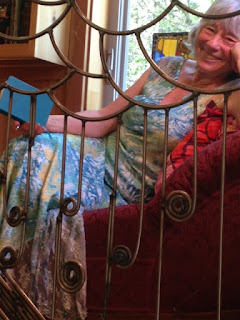I am one of those people Alan Powers describes in Living with Books who, “in case of sudden nocturnal literary deprivation,” go to bed with books immediately available. Therefore, my bedroom flows borderless into my library.
I had planned floor-to-ceiling
bookshelves in the library, but the cedar wainscoting is so beautiful my
builder couldn’t bear to cover it, so I sacrificed book space for wall space,
and Richard built half-height shelves. Because the bookcase on the west wall would
be at the top of the stairs and therefore the point to which the railing would
draw the eye when one entered the house, I told Richard to do something creative there. I gave him Living with
Books for inspiration and left the details up to him.
What he gave me was a bookshelf that
featured, in its center, a ceramic mask that once belonged to my mother. The shelves
end in curved cuts, like syncopated beats. Highly polished, deep red, square
manzanita posts hold up the shelves.
I would like to have put my most beloved
books – English and American literature – in that beautiful bookcase, but they are such a motley collection! Adam Bede's spine is torn, Ulysses's jacket has a rip in it, David Copperfield is altogether spineless, and so many
Faulkner novels are missing spines and covers, their pages held together with rubber bands,
that the whole clan from Yaknapatawpha County (even they) would be ashamed. I couldn’t
bring myself to put such unsightly books on such beautiful shelves.
So “most aesthetic collections,” not "most beloved literature," became
the criterion. The annual Best American Essays – all the same size, each a different color, from the moss green 1988
edition to the baby blue 2015 edition, all years inclusive – sit prettily on the bottom
shelf. John McPhee cozies up next to them, a respectable clan with only two or three unsightly
relatives included that couldn’t be omitted from the family reunion
Rising above McPhee is Nabokov, another
author whose complete works I own. Above Nabokov is Shakespeare, who generously shares his shelf with the work of other playwrights, the six
volumes of my Norton Anthology of English
Literature (heavily annotated for teaching), and a sizable collection of
food writing. On top of the bookcase a fine leather-bound edition of Moby Dick keeps strange company with T.
Coraghessan Boyle, Alice Walker, and Doris Lessing, though Ahab’s Wife sits suitably alongside it. The two bookends that hold that line of books upright – statues of a
boy stretching to reach the top of a high stack of books – came from the living room
of my childhood home.
On the south-wall shelves I paid
attention only to logical order. American literature flows left to right from Nathaniel Hawthorne through to Vonnegut and Pynchon (Faulkner in a bookcase on the other side of the window), while on the shelf below, English literature keeps pace through the centuries: Defoe, Austen, Hardy, Bronte, and now let us linger over the incomparable George Eliot before going on to Dickens, Woolf, and Joyce. The contemporary novelists, British
and American, that wouldn't fit on those shelves have leapt the divide to reside above the food literature on the west-wall shelves. The
arrangement isn’t logical, but I know where things are.
Poetry is in my writing nook, but art books have a shelf here, and nature books two shelves. Adjacent to these books France rubs elbows with Italy; Russia with Germany, Chile with Scandinavia, Japan with China, all in fiction. Pamuk represents Turkey, Mahfouz
Egypt, and Saramago Portugal. The tongues have mostly turned English, but some French, Latin, and Swedish books speak in their original languages. I seldom read anything in a foreign language any more, but I like
looking at the books and remembering when I could. Below the mythology and linguistics books and fun books about words on the next shelf are my sister Laura’s fifteen
books and some large books I couldn’t categorize: The Literary Cat, a Time-Life book on wilderness, a picture book of
Göteborg.
Arrangement of books is important in a library, but, as Powers says, "careful
consideration needs to be given to the relationship between the position in which
the reader is to sit and the rest of the room.” In my library this consideration resulted in a Victorian fainting couch under the south-facing window, perfect for reading, taking notes, day-dreaming, or falling asleep with a book.


In Living with Books Alan Powers says that reading the titles of books
in a home allows a person “to make a quick assessment of the character of the
occupant.” In this account of my library I have named many titles and authors (though only
a small portion of the whole), allowing you to make that quick assessment. Or
maybe you have experienced a sense of kinship, as I do when I see someone reading a book I have enjoyed: “Oh, I’ve read that book. It’s
wonderful!”
You are always welcome in my
library.






No comments:
Post a Comment